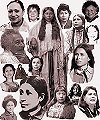 |
Ancient
Voices
A
Museum to honor the least known people in North America,
the Original Tribal Women |
Susan La Flesche Picotte (1865-1915)

the unstrung bow was a symbol used by the La Flesche family
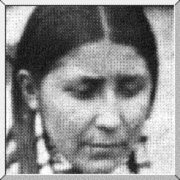
Susan La Flesche at her graduation
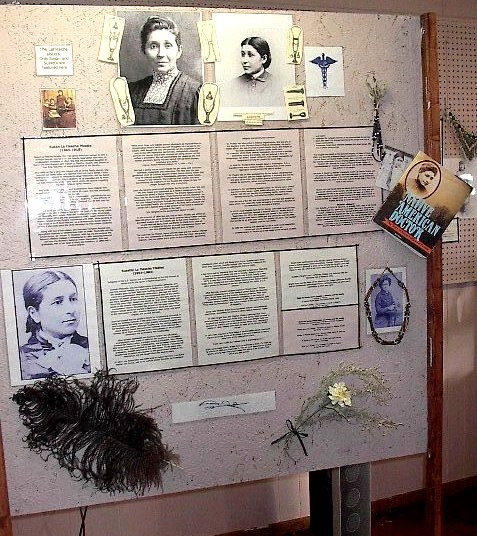
The LaFlesche sisters panel in the museum
Susan La Flesche Picotte, the first native American woman to earn a medical degree, was born on the Omaha reservation near Macy in northeastern Nebraska in 1865. She was the youngest daughter of Mary (The One Woman)and Joseph La Flesche. Mary was a daughter of Dr. John Gale and Ni-co-mi of the Iowa tribe. Joseph, also known as Iron Eye, was a son of Joseph La Flesche, a French trader and his wife, a woman of the Ponca tribe. Iron Eye was the last recognized chief of the Omaha.
As a child on the prairie she helped with all of the family chores. She followed her father often and learned from him many things - from herding to the wisdom he imparted to other tribesmen. But her father wanted her, and all the tribe's children, to be educated and to know her way around the white man's world which was quickly engulfing every native tribe in North America.
She suffered from a painful and degenerative bone disease that caused severe pain in her ear for about 20 years, and that eventually took her life.
She observed the white doctor on the reservation - sometimes he was slow, sometimes he seemed not to care. Realizing "...the difficulty of being in between worlds," she often wondered how to best help her people.
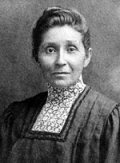
Between 1870 and 1879 Susan attended school on the reservation. At the age of 14, she enrolled at the Elizabeth Institute for Young Ladies at Elizabeth, New Jersey. Here she studied philosophy, physiology, and literature. After she was graduated in 1882, Susan worked at the Mission School on the Omaha reservation until 1884. While tending to the needs of an ill Alice Fletcher, an anthropologist, Susan began to wonder if she could learn the skills necessary to help people medically. Along with two of her sisters, she attended Hampton Normal and Agricultural Institute in Virginia from 1884 to 1886.
There she met the school doctor, Dr. Martha M. Waldron. With her aid she entered the Women's Medical College in Philadelphia in 1886, receiving financial aid from the Women's National Indian Association. She was graduated, first in her class of thirty-six members, in 1889 with a medical degree.
"What must those who oppose women physicians as impossibilities or monstrosities think of such a course? Thoughtful of a service to her people, child though she was, she permits not the magnitude of her task to stay the inspiration, but bravely, thoughtfully, diligently pursues the course, and to day receives her fitting reward. All this without a precedent. She will stand among her people as the first woman physician. Surely we may record with joy such courage, constancy and ability."
(Source: Medical Missionary Record, vol. 4, 1889, p. 126.)
She had a gentle nature which helped her get along with everyone, roomates, classmates and instructors. The next year she was gladdened when all Omahas became United States citizens. Susan had time for cultural pursuits in Philadelphia, attending social events, museums and concerts. She knew her half-brother was busy documenting the traditions of the Omaha and longed to help her people through this very trying time.
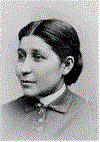
(Photographic reproduction: From collections of the National Anthropological Archives,
Smithsonian Institution, Photo. no. 4503)
Later she became government physician for the Omaha Tribe. She was the only Indian ever appointed as a medical missionary by the Presbyterian Board of Home Missions. The Omaha Agency school in Macy was her home and office. From there she not only doctored - on horseback, later a buggy, through days that were often 15 hours long - but also helped her people through the cultural changes.
Despite her own diminished health, she continued a daunting daily schedule and always left a lighted lamp in the window of her home to welcome patients in the night.
She resigned as the government doctor in 1893. In the summer of 1894 she was wed to Henry Picotte and settled at Bancroft where she cared for her family and her ailing mother and also provided medical care for Indians and for her white neighbors.
. The couple had two boys, Caryl and Pierre. In 1905 Henry died of alcoholism (a problem on the rise on most reservations). Susan and her sons moved from Bancroft back to Macy
The next year Dr. Picotte, along with her sons and her mother, moved to the new community of Walthill to live near her sister, Marguerite Diddock. The two sisters were active in the community, sponsoring religious and community activities.
Dr. Picotte was also active in medical organizations. She was one of the founders of the Thurston County Medical Association. As county health officer, she was involved in public health issues. She lobbied at the State Legislature for better public health laws.
As a member of the State Medical Association, Dr. Picotte worked to combat alcoholism among the Omaha, and she lectured in favor of temperance. Her father, Joseph LaFlesche, had worked successfully for temperance among the Omaha for many years. In 1906 Dr. Picotte's work brought about in Washington, D.C. a stipulation that every property deed in communities on the Omaha reservation would prohibit the sale of alcohol.
Dr. Picotte was an able spokesperson for her people, declaring that she would cooperate with the Indian Agencies in anything that was for the good of the tribe. She battled government bureaucracy and worked for economic, social, and spiritual advancement of native Americans.
In addition to her pioneering medical career, Dr. Picotte was a church and community leader, public health advocate, and Indian rights activist. Her life was devoted to promoting health, healing illness, serving community, and fostering respect between races.
Letter from Picotte to Commissioner of Indian Affairs Francis E. Leupp, November 15, 1907.
Color reproduction of letter: Courtesy of the National Archives and Records Administration.
Near the end of her life, she accomplished a goal that had eluded her many years. She raised the funds necessary to construct a hospital on the reservation in the town of Walthill.
In 1912 a new hospital, built for Dr. Picotte with funds received from grants and donations, opened in Walthill. After Dr. Picotte died on September 18, 1915, the hospital was named in her honor. The hospital served both Native Americans and whites for over 30 years, then served as an elder care center for another 20 years. The hospital existed until the late 1940s. In 1989 the building was restored by a local multi-racial committee whose goal was to establish a center to:
- commemorate Dr. Picotte as a role model of the servant, student, and healer;
- celebrate the cultural diversity of the communities she served;
- learn and teach the shared histories of the people who live in these communities;
- encourage cooperative relations between the racial groups who live in these communities
The hospital was listed on the National Register of Historic Places in 1989, and declared a National Historic Landmark in 1993. It is owned by the Susan La Flesche Picotte Center, Inc., a private, non-profit, tax-exempt corporation. It now displays photos and artifacts from Dr. Picotte's life. Named the Susan La Flesche Picotte Center, it commemorates Dr. Picotte's medical work and her life, dedicated to the welfare of her people.
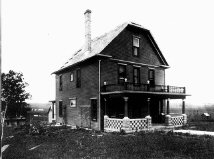
Because of Joseph La Flesche's foresight, Susan La Flesche Picotte and the other La Flesche children were well educated. In order to work effectively for the welfare of the Omaha and other native Americans, they adapted to the ways of the white culture around them. They truly lived in two cultures.

"Susan truly had faced obstacles above and beyond those faced by nineteenth century white women, yet she overcame every one and dedicated her life to her grateful people. Her story is a litany of frontier vignettes of which classic legends are made, and it needs no embellishment. Dr. Susan could very well emerge as one of the more notable heroines in American History."
Picotte's obituary:
"DR. SUSAN LA FLESCHE PICOTTE, of Walthill, Neb., died at her home on September 18, aged forty-nine years. She was a daughter of Pierre La Flesche, or Iron Eye, the last of the great chiefs of the Omaha tribe, and had devoted her life to the interests of her tribe, by whom she was regarded as the leader. She was graduated from the Woman's Medical College of Pennsylvania in the class of 1889 and was a member of the Nebraska State Medical Society."
(Source: Transactions of the Annual Meeting of the Alumnae Association of the Woman's Medical College of Pennsylvania, vol. 41, 1916, p. 35.)
Read the Books about Susan La Flesche and her family
 |
Homeward the Arrow's Flight: The Story of Susan La Flesche,
(Dr. Susan La Flesche Picotte)
by Marion Marsh Brown |
 |
Native American Doctor:
The Story of Susan La Flesche Picotte.
by Ferris, J. (1991). |
 |
Susan La Flesche Picotte M.D.
Omaha Indian Leader & Reformer
by Benson Tong |
 |
A Doctor to Her People
Dr. Susan La Flesche Picotte
by J.L. Wilkerson |
 |
Iron Eye's Family:
The Children of Joseph La Flesche
by Norma Kidd Green |
See more on Susette La Flesche's page |

















